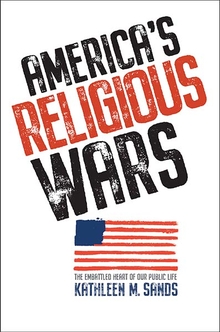It’s Not About Religion
Kathleen M. Sands—
Recently, the Supreme Court decided about the forty foot “Peace Cross” that’s stood for nearly a century in Bladensburg, Maryland. For the American Legion, the Cross memorializes the dead of World War I; for American Humanists, it broadcasts an unconstitutional government preference for a particular religion. The Court kicked the can with a plurality decision by Justice Alito. The Peace Cross can stay because it’s been in that spot for almost a century, it’s not coercive, and taking it down would seem hostile to religion.
But on a road as rough and winding as church-state jurisprudence, the kicked can may land in the woods. And it has. Non-coercion is a minimal standard for compliance with the Establishment clause, but is it enough? The age of a monument may count toward its legitimacy, but haven’t longstanding practices been found unconstitutional? And what about the Lemon/Endorsement test, which calls for a “secular” purpose and hinges on how a “reasonable observer” would interpret the Cross? Is the Lemon test inapplicable to this case but applicable to others, or applicable to all Establishment cases, or applicable to none? Does the Establishment clause exist only to protect religious freedom, or does it have other purposes, like minimizing divisions and limiting government? Can the government favor a particular religion? If not, can it favor religion in a general sense? Then again, is there really such a thing as “religion in general,” something that includes all the “religions” but excludes “the secular”?
In some ways, this case recalls the battle over King James religious devotions in public schools, which began in the nineteenth century and ended only in 1963 when the Court forbade school sponsored prayer. Not in terms of coercion; the King James devotions were coercive; the Cross is not. But in both conflicts, an ingroup felt religion to be foundational, an outgroup felt persecuted or shut out, each responding to the other with bewilderment and fury. For nineteenth century Protestants, King James devotions were “nonsectarian,” a compromise among their denominations, struck for the sake of fostering citizenship in children. The Alito plurality pointed out that a Catholic priest had joined a Baptist minister to dedicate the Peace Cross in 1925, and that both black and white soldiers were memorialized there. From some vantage points, then, the King James devotions and the Peace Cross healed divisions. From other vantage points, they were broken from the beginning.
An odd thing about foundationalist religion is that to its proponents it isn’t particularly religious. To many Protestants, nonsectarianism was simply American; to Catholics, it was obviously Protestant. The voluble Archbishop John Hughes argued in 1840 that all religion was sectarian, even his own, but to no avail at the time. Despite battles on streets and in courtrooms, nonsectarianiam held sway until the Supreme Court’s 1963 decision banning school-sponsored prayer – to many Americans, a long-awaited relief; to others, a gratuitous injury.
The Peace Cross, a vestige of nonsectarianism, has been a new battle in America’s oldest war. Who is remembered or forgotten, grieved or not grieved? Are there any symbols or words around which we can gather? If so, which ones? If not, might it be better not to pretend? Because the battle is fought in terms of the Establishment clause, we think it’s about “religion.” But might “religion” itself be a symbol for fault lines in the foundations of our polity?
In the Peace Cross case, nobody ventured a generic concept of religion. In oral arguments, “sectarian” was uttered dozens of times, but never “nonsectarian.” Instead, sectarian became a synonym for “religion,” and its opposite became “the secular.” They were right to do this; no generic can represent the diversity of American beliefs, much less represent non-religious Americans. But if there’s no such thing as generic religion, then what makes the various religions “religious”? And what makes the religious different than the secular?
“Religion,” being a symbol, is neither what truly ails us nor what could truly heal us. But there it is in the Constitution, like the Bladensburg Cross, cracked but still standing—a memory, a provocation, a hazard and a hope, a question unanswered because it is not yet well-asked.
Kathleen M. Sands is professor of American studies at the University of Hawai?i at Manoa and the author of Escape from Paradise: Evil and Tragedy in Feminist Theology.
Further Reading:



























